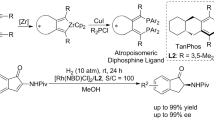Summary
N-[(Z)-N-Benzoyl- orN-Boc-(2-fluorophenyl)dehydroalanyl]-(R)-or (S)-phenylalanine esters were synthesized and hydrogenated to give the corresponding dipeptide derivatives with optical yields in the range of 53–87%de using the cationic rhodium complexes of PROPRAPHOS and BPPM. The efficiency of chiral diphosphine ligands as well the effect of the chiral center in the substrate on the catalytic asymmetric induction was studied.
Similar content being viewed by others
References
Anderson GW, Zimmermann JE, Callahan FM (1967) A reinvestigation of the mixed carbonic anhydride method of peptide synthesis. J Am Chem Soc 89: 5012–5017
Bennett EL, Niemann C (1950) The preparation and resolution of the three isomeric nuclear substituted monofluoro-DL-phenylalanines. J Am Chem Soc 72: 1800–1803
Doherty DG, Tietzmann JE, Bergmann M (1943) Peptides of dehydrogenated amino acids. J Biol Chem 147: 617–637
Krause HW, Kreuzfeld HJ, Döbler Chr, Taudien S (1992) Unusual amino acids. II. Asymmetric synthesis of fluorine containing phenylalanines. Tetrahedron: Asymmetry 3: 555–566
Krause HW, Kreuzfeld HJ, Schmidt U, Döbler Chr, Michalik M, Taudien S, Fischer Chr (1996) Unusual amino-acids VI. Substituted arylamino acids by asymmetric hydrogenation of N-Cbz and N-Boc protected dehydroamino acid derivatives. Chirality 8: 173–188
Kreuzfeld HJ, Döbler Chr, Schmidt U, Krause HW (1996) Synthesis of non-proteinogenic (D)- or (L)-amino acids by asymmetric hydrogenation. Amino Acids 11: 269–282.
Meyer D, Poulin J-C, Kagan HB, Levine-Pinto H, Morgat J-L, Fromageot P (1980) Stereoselective synthesis of dipeptides by asymmetric reduction of dehydrodipeptides catalyzed by chiral rhodium complexes. J Org Chem 45: 4680–4682
Ojima I (1982) Novel approaches to the asymmetric synthesis of peptides. ACS Symp Ser 185 (Asymmetric React Processes Chem): 109–138
Ojima I (1984) Homogeneous asymmetric catalysis by means of chiral rhodium complexes. Pure Appl Chem 56/1: 99–110
Ojima I, Suzuki T (1980) Asymmetric synthesis of dipeptides by means of homogeneous hydrogenation catalyzed by chiral rhodium complexes. Tetrahedron Letters 21: 1239–1242
Ojima I, Kogure T, Yoda N, Suzuki T, Yatabe M, Tanaka T (1982) Synthesis of chiral dipeptides by means of asymmetric hydrogenation of dehydro dipeptides. J Org Chem 47/7: 1329–1334
Onuma K, Ito T, Nakamura A (1980) The asymmetric hydrogenation of theα-N-acetylamino cinnamoyl derivative of amino acids with chiral bisphosphine-rhodium complex. Chem Lett: 481–482
Shin C, Yonezawa Y, Obara T, Nishio H (1988) Dehydrooligopeptides VIII. Convenient synthesis of various dehydrotyrosine derivatives protected with useful N,Oprotecting group via N-carboxy dehydrotyrosine anhydrides. Bull Chem Soc Jpn 61: 885–891
Shin C, Obara T, Taniguchi S, Yonezawa Y (1989) Dehydrooligopeptides XI. Facile syntheses of various kinds of dehydrodi- and tripeptides, and dehydroenkephalins containing ΔTyr residue by using N-carboxydehydrotyrosine anhydride. Bull Chem Soc Jpn 62: 1127–1135
Sinou D, Lafont D, Descotes D (1981) Reduction of dehydrodipeptides catalyzed by the complex Rh1-DIOXOP. J Organomet Chem 217: 119–127
Yamagishi T, Yatagai M, Hatakeyama H, Hida M (1984) Asymmetric hydrogenation of dehydroaminoacids and dehydrodipeptides with rhodium(I)-modified DIOP catalysts. Bull Chem Soc Jpn 57: 1897–1901
Yamagishi T, Ikeda S, Yatagai M, Yamaguchi M, Hida M (1988) Efficient 1,4-asymmetric induction utilizing electrostatic interaction between ligand and substrate in the asymmetric hydrogenation of didehydrodipeptides. J Chem Soc Perkin Trans I: 1787–1790
Yatagai M, Zama M, Yamagishi T, Hida M (1983) Effective asymmetric hydrogenation of dehydrodipeptides with rhodium(I)- new chiral diphosphinite systems. Chem Lett: 1203–1206
Yatagai M, Zama M, Yamagishi T, Hida M (1984a) Asymmetric hydrogenation with rhodium-(I)-chiral diphosphinites. The effect of the dimethylamino group of the ligand on the asymmetric induction. Bull Chem Soc Jpn 57: 739–746
Yatagai M, Yamagishi T, Hida M (1984b) Asymmetric hydrogenation of dehydrodipeptides with rhodium(I)-chiral diphosphinites. Selective (SS)- and (RR)-product formation by double asymmetric induction. Bull Chem Soc Jpn 57: 823–826
Author information
Authors and Affiliations
Additional information
Dedicated to Professor Günther Oehme on the occasion of his 60th birthday
Rights and permissions
About this article
Cite this article
Döbler, C., Kreuzfeld, H.J., Fischer, C. et al. Asymmetric hydrogenation of dehydrodipeptide esters bearing different protective groups. Amino Acids 16, 391–401 (1999). https://doi.org/10.1007/BF01388178
Received:
Accepted:
Issue Date:
DOI: https://doi.org/10.1007/BF01388178



